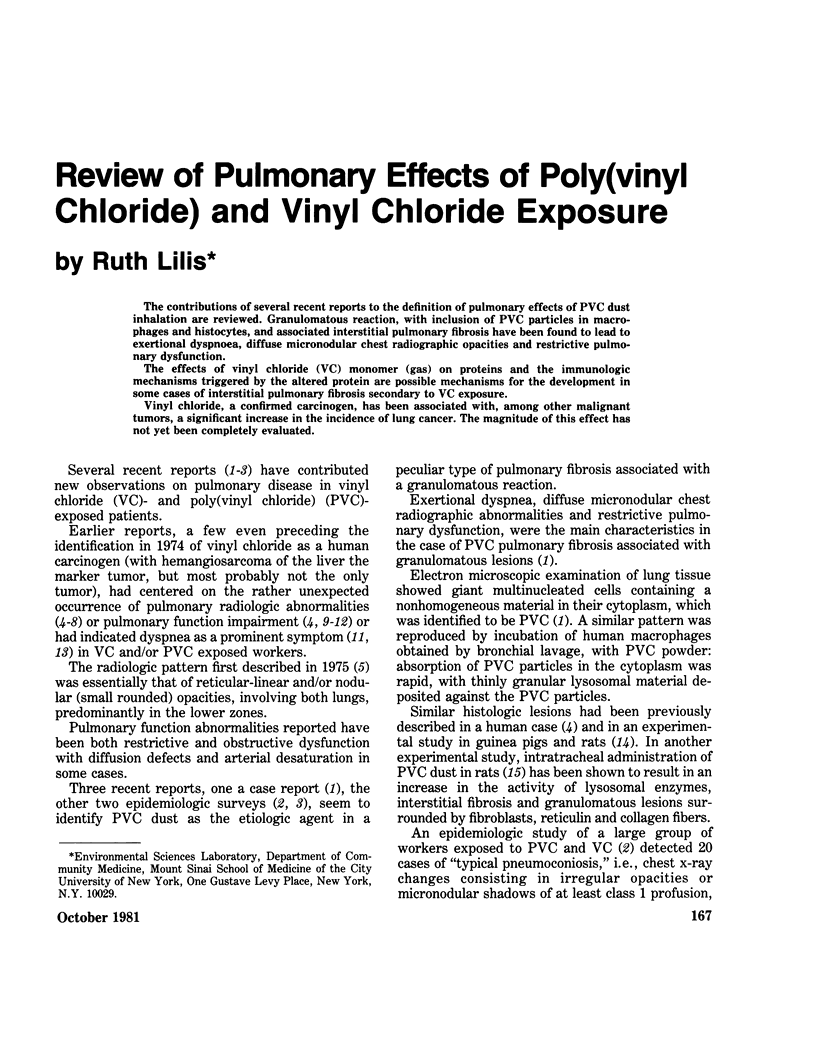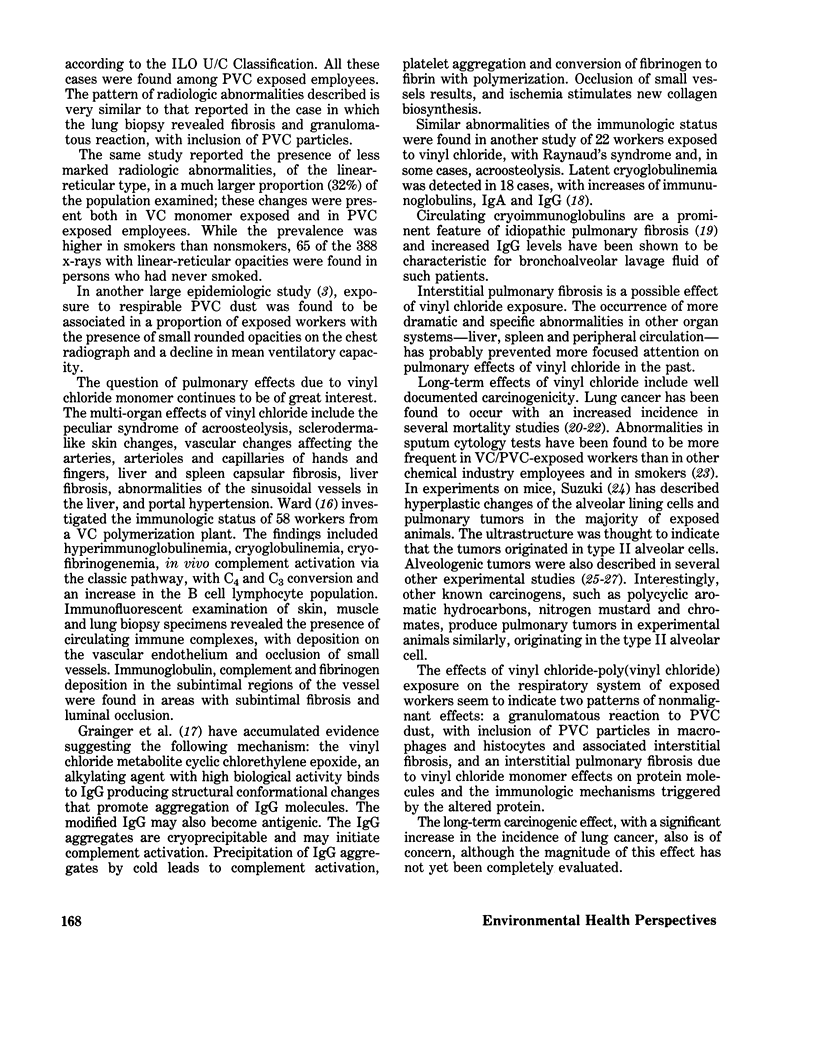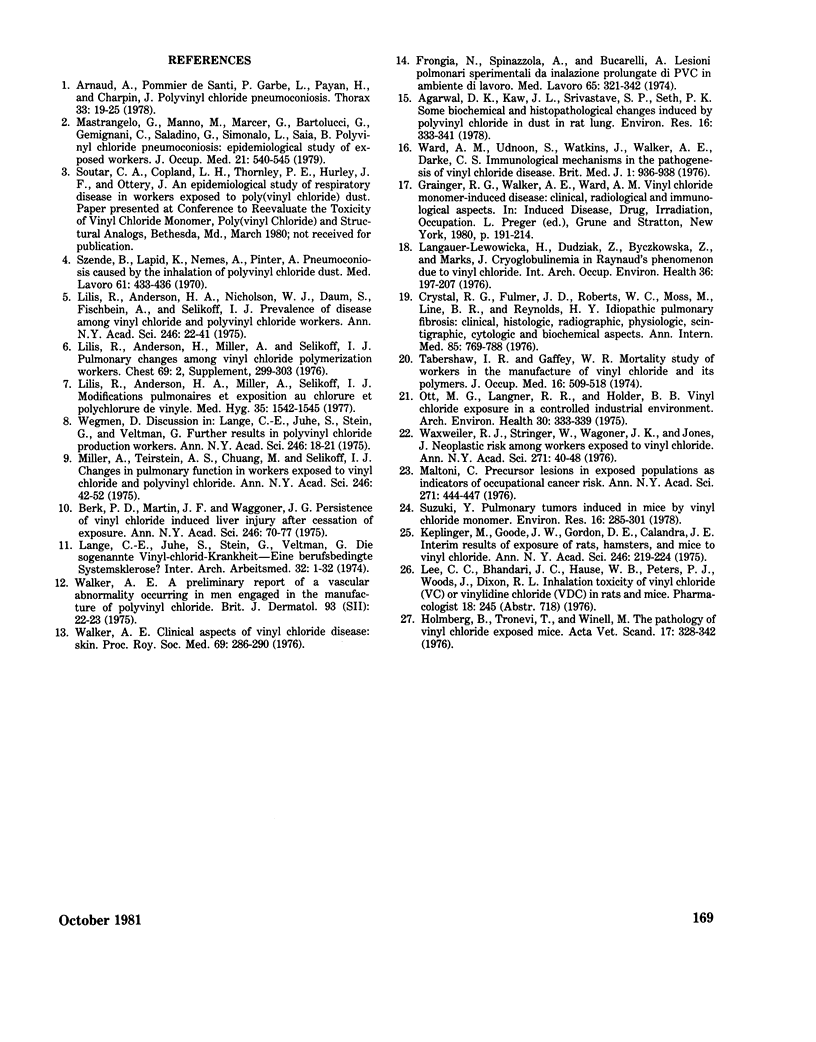Abstract
The contributions of several recent reports to the definition of pulmonary effects of PVC dust inhalation are reviewed. Granulomatous reaction, with inclusion of PVC particles in macrophages and histocytes, and associated interstitial pulmonary fibrosis have been found to lead to exertional dyspnoea, diffuse micronodular chest radiographic opacities and restrictive pulmonary dysfunction. The effects of vinyl chloride (VC) monomer (gas) on proteins and the immunologic mechanisms triggered by the altered protein are possible mechanisms for the development in some cases of interstitial pulmonary fibrosis secondary to VC exposure. Vinyl chloride, a confirmed carcinogen, has been associated with, among other malignant tumors, a significant increase in the incidence of lung cancer. The magnitude of this effect has not yet been completely evaluated.
Full text
PDF


Selected References
These references are in PubMed. This may not be the complete list of references from this article.
- Agarwal D. K., Kaw J. L., Srivastava S. P., Seth P. K. Some biochemical and histopathological changes induced by polyvinyl chloride dust in rat lung. Environ Res. 1978 Jul;16(1-3):333–341. doi: 10.1016/0013-9351(78)90166-4. [DOI] [PubMed] [Google Scholar]
- Arnaud A., Pommier de Santi P. P., Garbe L., Payan H., Charpin J. Polyvinyl chloride pneumoconiosis. Thorax. 1978 Feb;33(1):19–25. doi: 10.1136/thx.33.1.19. [DOI] [PMC free article] [PubMed] [Google Scholar]
- Berk P. D., Martin J. F., Waggoner J. G. Persistence of vinyl chloride-induced liver injury after cessation of exposure. Ann N Y Acad Sci. 1975 Jan 31;246:70–77. doi: 10.1111/j.1749-6632.1975.tb51081.x. [DOI] [PubMed] [Google Scholar]
- Crystal R. G., Fulmer J. D., Roberts W. C., Moss M. L., Line B. R., Reynolds H. Y. Idiopathic pulmonary fibrosis. Clinical, histologic, radiographic, physiologic, scintigraphic, cytologic, and biochemical aspects. Ann Intern Med. 1976 Dec;85(6):769–788. doi: 10.7326/0003-4819-85-6-769. [DOI] [PubMed] [Google Scholar]
- Frongia N., Spinazzola A., Bucarelli A. Lesioni polmonari sperimentali da inalazione prolungata di polveri di PVC in ambiente di lavoro. Med Lav. 1974 Sep-Oct;65(9-10):321–342. [PubMed] [Google Scholar]
- Holmberg B., Kronevi T., Winell M. The pathology of vinyl chloride exposed mice. Acta Vet Scand. 1976;17(3):328–342. doi: 10.1186/BF03547913. [DOI] [PMC free article] [PubMed] [Google Scholar]
- Keplinger M. L., Goode J. W., Gordon D. E., Calandra J. C. Interim results of exposure of rats, hamsters, and mice to vinyl chloride. Ann N Y Acad Sci. 1975 Jan 31;246:219–224. doi: 10.1111/j.1749-6632.1975.tb51095.x. [DOI] [PubMed] [Google Scholar]
- Langauer-Lewowicka H., Dudziak Z., Byczkowska Z., Marks J. Cryoglobulinemia in Raynaud's phenomenon due to vinyl chloride. Int Arch Occup Environ Health. 1976 Jan 26;36(3):197–207. doi: 10.1007/BF00378274. [DOI] [PubMed] [Google Scholar]
- Lange C. E., Jühe S., Stein G., Veltman G. Further results in polyvinyl chloride production workers. Ann N Y Acad Sci. 1975 Jan 31;246:18–21. doi: 10.1111/j.1749-6632.1975.tb51077.x. [DOI] [PubMed] [Google Scholar]
- Lilis R., Anderson H., Miller A., Selikoff I. J. Pulmonary changes among vinyl chloride polymerization workers. Chest. 1976 Feb;69(2 Suppl):299–303. doi: 10.1378/chest.69.2.299. [DOI] [PubMed] [Google Scholar]
- Lilis R., Anderson H., Nicholson W. J., Daum S., Fischbein A. S., Selikoff I. J. Prevalence of disease among vinyl chloride and polyvinyl chloride workers. Ann N Y Acad Sci. 1975 Jan 31;246:22–41. doi: 10.1111/j.1749-6632.1975.tb51078.x. [DOI] [PubMed] [Google Scholar]
- Maltoni C. Precursor lesions in exposed populations as indicators of occupational cancer risk. Ann N Y Acad Sci. 1976;271:444–447. doi: 10.1111/j.1749-6632.1976.tb23145.x. [DOI] [PubMed] [Google Scholar]
- Mastrangelo G., Manno M., Marcer G., Bartolucci G. B., Gemignani C., Saladino G., Simonato L., Saia B. Polyvinyl chloride pneumoconiosis: epidemiological study of exposed workers. J Occup Med. 1979 Aug;21(8):540–542. [PubMed] [Google Scholar]
- Miller A., Teirstein A. S., Chuang M., Selikoff I. J., Warshaw R. Changes in pulmonary function in workers exposed to vinyl chloride and polyvinyl chloride. Ann N Y Acad Sci. 1975 Jan 31;246:42–52. doi: 10.1111/j.1749-6632.1975.tb51079.x. [DOI] [PubMed] [Google Scholar]
- Ott M. G., Langer R. R., Holder B. B. Vinyl chloride exposure in a controlled industrial environment. A long-term mortality experience in 594 employees. Arch Environ Health. 1975 Jul;30(7):333–339. doi: 10.1080/00039896.1975.10666716. [DOI] [PubMed] [Google Scholar]
- Suzuki Y. Pulmonary tumors induced in mice by vinyl chloride monomer. Environ Res. 1978 Jul;16(1-3):285–301. doi: 10.1016/0013-9351(78)90163-9. [DOI] [PubMed] [Google Scholar]
- Szende B., Lapis K., Nemes A., Pinter A. Pneumoconiosis caused by the inhalation of polyvinylchloride dust. Med Lav. 1970 Aug-Sep;61(8):433–436. [PubMed] [Google Scholar]
- Tabershaw I. R., Gaffey W. R. Mortality study of workers in the manufacture of vinyl chloride and its polymers. J Occup Med. 1974 Aug;16(8):509–518. [PubMed] [Google Scholar]
- Walker A. E. Clinical aspects of vinyl chloride disease: skin. Proc R Soc Med. 1976 Apr;69(4):286–289. [PMC free article] [PubMed] [Google Scholar]
- Ward A. M., Udnoon S., Watkins J., Walker A. E., Darke C. S. Immunological mechanisms in the pathogenesis of vinyl chloride disease. Br Med J. 1976 Apr 17;1(6015):936–938. doi: 10.1136/bmj.1.6015.936. [DOI] [PMC free article] [PubMed] [Google Scholar]
- Waxweiler R. J., Stringer W., Wagoner J. K., Jones J., Falk H., Carter C. Neoplastic risk among workers exposed to vinyl chloride. Ann N Y Acad Sci. 1976;271:40–48. doi: 10.1111/j.1749-6632.1976.tb23091.x. [DOI] [PubMed] [Google Scholar]


